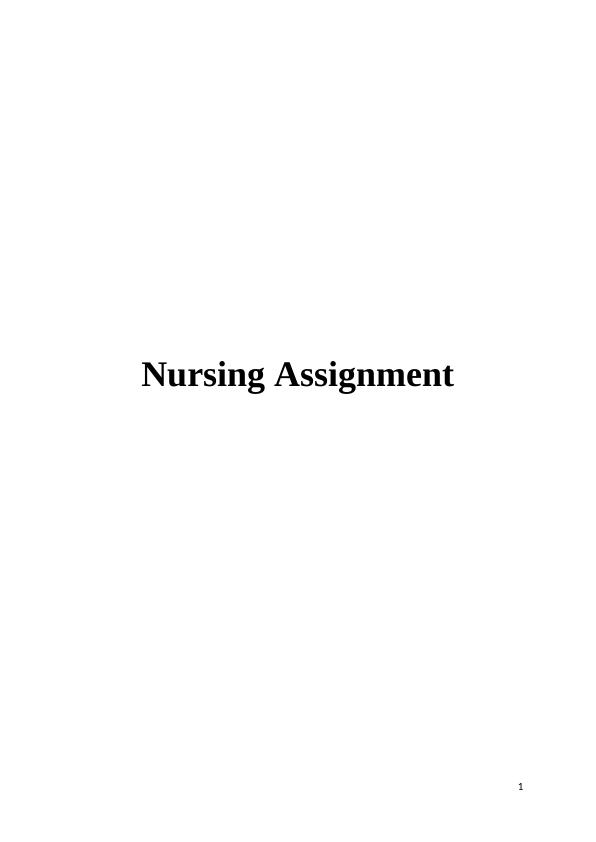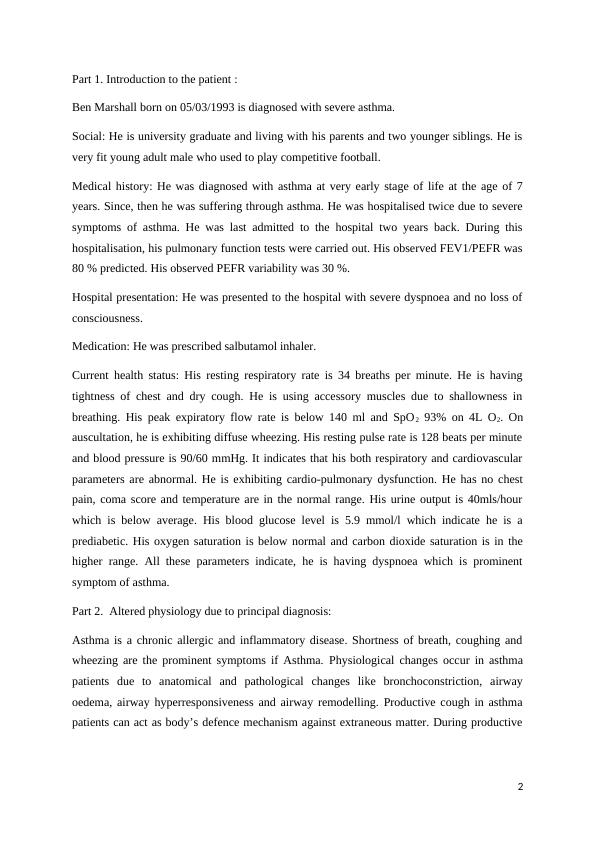Physiological Changes in Asthma Patients: A Case Study of Ben Marshall
Added on 2023-06-12
10 Pages3223 Words254 Views
Nursing Assignment
1
1

Part 1. Introduction to the patient :
Ben Marshall born on 05/03/1993 is diagnosed with severe asthma.
Social: He is university graduate and living with his parents and two younger siblings. He is
very fit young adult male who used to play competitive football.
Medical history: He was diagnosed with asthma at very early stage of life at the age of 7
years. Since, then he was suffering through asthma. He was hospitalised twice due to severe
symptoms of asthma. He was last admitted to the hospital two years back. During this
hospitalisation, his pulmonary function tests were carried out. His observed FEV1/PEFR was
80 % predicted. His observed PEFR variability was 30 %.
Hospital presentation: He was presented to the hospital with severe dyspnoea and no loss of
consciousness.
Medication: He was prescribed salbutamol inhaler.
Current health status: His resting respiratory rate is 34 breaths per minute. He is having
tightness of chest and dry cough. He is using accessory muscles due to shallowness in
breathing. His peak expiratory flow rate is below 140 ml and SpO2 93% on 4L O2. On
auscultation, he is exhibiting diffuse wheezing. His resting pulse rate is 128 beats per minute
and blood pressure is 90/60 mmHg. It indicates that his both respiratory and cardiovascular
parameters are abnormal. He is exhibiting cardio-pulmonary dysfunction. He has no chest
pain, coma score and temperature are in the normal range. His urine output is 40mls/hour
which is below average. His blood glucose level is 5.9 mmol/l which indicate he is a
prediabetic. His oxygen saturation is below normal and carbon dioxide saturation is in the
higher range. All these parameters indicate, he is having dyspnoea which is prominent
symptom of asthma.
Part 2. Altered physiology due to principal diagnosis:
Asthma is a chronic allergic and inflammatory disease. Shortness of breath, coughing and
wheezing are the prominent symptoms if Asthma. Physiological changes occur in asthma
patients due to anatomical and pathological changes like bronchoconstriction, airway
oedema, airway hyperresponsiveness and airway remodelling. Productive cough in asthma
patients can act as body’s defence mechanism against extraneous matter. During productive
2
Ben Marshall born on 05/03/1993 is diagnosed with severe asthma.
Social: He is university graduate and living with his parents and two younger siblings. He is
very fit young adult male who used to play competitive football.
Medical history: He was diagnosed with asthma at very early stage of life at the age of 7
years. Since, then he was suffering through asthma. He was hospitalised twice due to severe
symptoms of asthma. He was last admitted to the hospital two years back. During this
hospitalisation, his pulmonary function tests were carried out. His observed FEV1/PEFR was
80 % predicted. His observed PEFR variability was 30 %.
Hospital presentation: He was presented to the hospital with severe dyspnoea and no loss of
consciousness.
Medication: He was prescribed salbutamol inhaler.
Current health status: His resting respiratory rate is 34 breaths per minute. He is having
tightness of chest and dry cough. He is using accessory muscles due to shallowness in
breathing. His peak expiratory flow rate is below 140 ml and SpO2 93% on 4L O2. On
auscultation, he is exhibiting diffuse wheezing. His resting pulse rate is 128 beats per minute
and blood pressure is 90/60 mmHg. It indicates that his both respiratory and cardiovascular
parameters are abnormal. He is exhibiting cardio-pulmonary dysfunction. He has no chest
pain, coma score and temperature are in the normal range. His urine output is 40mls/hour
which is below average. His blood glucose level is 5.9 mmol/l which indicate he is a
prediabetic. His oxygen saturation is below normal and carbon dioxide saturation is in the
higher range. All these parameters indicate, he is having dyspnoea which is prominent
symptom of asthma.
Part 2. Altered physiology due to principal diagnosis:
Asthma is a chronic allergic and inflammatory disease. Shortness of breath, coughing and
wheezing are the prominent symptoms if Asthma. Physiological changes occur in asthma
patients due to anatomical and pathological changes like bronchoconstriction, airway
oedema, airway hyperresponsiveness and airway remodelling. Productive cough in asthma
patients can act as body’s defence mechanism against extraneous matter. During productive
2

cough, there is expulsion of phlegm harmful substances from the lungs (Bonini and Usmani
2015; Bausewein and Simon, 2013).
Physiological aspects of the respiratory system mainly depend on the factors like oxygen
transfer across the alveolus and blood vessels. Function of respiration is to supply oxygen to
different tissues and elimination of carbon dioxide from the blood back into the alveolus and
from alveolus to the external environment through expiration (West, 2012). In asthma
patients like Ben there is impairment in the normal physiological process of the respiratory
system. As a result of impaired physiology of the respiratory system, there is impaired
gaseous exchange. Alveolar and blood capillaries interface is the main site for the gaseous
exchange. At this interface, oxygen enters the bloodstream and bind to haemoglobin present
in the blood. This binding depends on the partial pressure of oxygen (PaO2). It indicates exact
amount of oxygen present in the blood stream (Bateman et al., 2015). Exact amount of carbon
dioxide present can be indicated by partial pressure of carbon dioxide (PaCO2). Normal PaO2
range should be between 75 to 100 mmHg. However, in Ben PaO2 value is less i.e. 70
mmHg. It indicates less amount of oxygen in the blood. Normal PaCO2 range should be
between 35 to 45 mmHg (Krishnan et al., 2012). However, in Ben PaCO2 value is more i.e.
45 mmHg. Even though carbon dioxide value is in the normal range, it is extreme at higher
end. Hence, it can be considered as the higher value. It indicates less amount of oxygen in
the blood. With increase or decrease of PaO2, there is also increase or decrease in SpO2
which indicate peripheral capillary oxygen saturation. In Ben, observed SpO2 is 93 %.
Normal SpO2 in adults should be between 94 to 99 %. During normal respiration, SpO2
remains normal; however, during respiratory impairment, SpO2 get reduced. Depression of
the respiratory system can occur due to weakness of the respiratory muscles. Peak expiratory
flow rate (PEFR) is the maximal rate expiration after the full inspiration. There is a
correlation between the PEFR and forced expiratory volume in one second (FEV1). In
patients with asthma, PEFR get reduced due to the constriction of the airways (Hillman et al.,
2014; Shiner & Steier, 2012).
On auscultation, diffuse and auditory inspiratory and expiratory wheezes are observed in Ben.
It indicates asthma in Ben. Wheezing is the whistling sound due to the exhaled air. Main
reason for the occurrence of wheezing sound in asthma patients is mainly due to the forceful
flow of air through the constricted and narrow airways. In Asthma patients, narrowing of the
airways mainly occurs due to inflammation and mucus deposition (Kim et al., 2012).
Narrowing of airways also lead to breathing insufficiency and dyspnoea. Due to dyspnoea,
3
2015; Bausewein and Simon, 2013).
Physiological aspects of the respiratory system mainly depend on the factors like oxygen
transfer across the alveolus and blood vessels. Function of respiration is to supply oxygen to
different tissues and elimination of carbon dioxide from the blood back into the alveolus and
from alveolus to the external environment through expiration (West, 2012). In asthma
patients like Ben there is impairment in the normal physiological process of the respiratory
system. As a result of impaired physiology of the respiratory system, there is impaired
gaseous exchange. Alveolar and blood capillaries interface is the main site for the gaseous
exchange. At this interface, oxygen enters the bloodstream and bind to haemoglobin present
in the blood. This binding depends on the partial pressure of oxygen (PaO2). It indicates exact
amount of oxygen present in the blood stream (Bateman et al., 2015). Exact amount of carbon
dioxide present can be indicated by partial pressure of carbon dioxide (PaCO2). Normal PaO2
range should be between 75 to 100 mmHg. However, in Ben PaO2 value is less i.e. 70
mmHg. It indicates less amount of oxygen in the blood. Normal PaCO2 range should be
between 35 to 45 mmHg (Krishnan et al., 2012). However, in Ben PaCO2 value is more i.e.
45 mmHg. Even though carbon dioxide value is in the normal range, it is extreme at higher
end. Hence, it can be considered as the higher value. It indicates less amount of oxygen in
the blood. With increase or decrease of PaO2, there is also increase or decrease in SpO2
which indicate peripheral capillary oxygen saturation. In Ben, observed SpO2 is 93 %.
Normal SpO2 in adults should be between 94 to 99 %. During normal respiration, SpO2
remains normal; however, during respiratory impairment, SpO2 get reduced. Depression of
the respiratory system can occur due to weakness of the respiratory muscles. Peak expiratory
flow rate (PEFR) is the maximal rate expiration after the full inspiration. There is a
correlation between the PEFR and forced expiratory volume in one second (FEV1). In
patients with asthma, PEFR get reduced due to the constriction of the airways (Hillman et al.,
2014; Shiner & Steier, 2012).
On auscultation, diffuse and auditory inspiratory and expiratory wheezes are observed in Ben.
It indicates asthma in Ben. Wheezing is the whistling sound due to the exhaled air. Main
reason for the occurrence of wheezing sound in asthma patients is mainly due to the forceful
flow of air through the constricted and narrow airways. In Asthma patients, narrowing of the
airways mainly occurs due to inflammation and mucus deposition (Kim et al., 2012).
Narrowing of airways also lead to breathing insufficiency and dyspnoea. Due to dyspnoea,
3

End of preview
Want to access all the pages? Upload your documents or become a member.
Related Documents
Understanding Asthma: Etiology, Diagnosis, Pathogenesis, Treatment and Preventionlg...
|13
|2528
|390
Acute Severe Asthma: Pathogenesis, Nursing Strategies, and Drug Mechanismslg...
|9
|2116
|88
Asthma and COPD Case | Assessmentlg...
|10
|3472
|19
Showing Various Clinical Manifestationslg...
|9
|2093
|30
Understanding Asthma: Symptoms, Pathogenesis, and Nursing Strategieslg...
|11
|2778
|245
Asthma Managementlg...
|6
|1523
|54